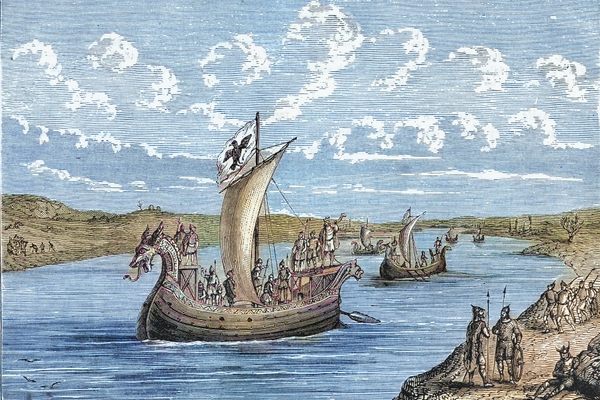Vikings from a Mass Grave and Their Warship Storm London
The Lewis Chessmen, berserkers. Late 12th century, Uig, Lewis, Scotland. Walrus ivory (© The Trustees of the British Museum)
The longest Viking ship ever discovered and the recently unearthed remains of some of the warriors who once roamed in the swift and sure vessels have stormed into London’s British Museum. Vikings: Life and Legend which opened earlier this month brings together many artifacts that have never left Scandinavia, as well as some fragments of skeletons found in a mass grave in England.
The centerpiece is without a doubt the Roskilde 6. Along with eight other vessels its timbers were found in the harbor of Roskilde, Denmark in 1996, and the bits of the oaken vessel are the longest intact Viking ship ever found at 117 feet. Only 20% of the hull survives, and the rest is structured with a metal skeleton, but through the collage of history and reconstruction you can get the time traveling sensation of the terror the Viking warriors once inspired as their curved vessels approached foreign shores.
The installation of Roskilde 6 at the British Museum in the Sainsbury Exhibitions Gallery, January 2014 (© Paul Raftery)
Of course, the Vikings as violent raiders is only part of their story. Much of the contribution to their legacy of grisly rampages is that their history was oral, so the written accounts of the people collectively known as the Vikings between the 8th and 11th centuries was predominately written by the people they attacked (people with whom they happily traded were much less verbose in their accounts). Thus you get poems like this which is included in the exhibition:
“Men will quake with terror
Before the seventy sea-oars
Are given deserved respite
From the labours of the ocean.”
Nevertheless, the warrior side of the Vikings isn’t entirely myth, as the exhibition shows. The Roskilde 6 was equipped with 40 pairs of oarsmen and probably served to transport troops over the North Sea. In the British Museum’s new Sainsbury Exhibitions Gallery, it is surrounded by axes and swords and even pieces of actual Vikings.
Sword, late 8th–early 9th century. Kalundborg or Holbæk, Zealand, Denmark. (Photo: John Lee, © The National Museum of Denmark)
Back in 2009 in Dorset, a gruesome Viking mass grave was discovered in a quarry with around 50 skeletons. Each one was decapitated and all the skulls tossed into a pile together. According to the BBC, the invaders were likely executed at their gravesite and quickly buried, and wounds show that the men didn’t give their lives easily. Some decapitations took multiple blows (one jaw bone was totally sliced through). And although many of them were quite young, they likely presented a fierce sight to England: one skeleton showed teeth filed down to intimidating points.
After the British Museum and the exhibition’s tour to Berlin, the skeleton pieces will all return to Dorset for display in their own museum, where the Vikings have come a long way from feared invaders prowling across the waters in their narrow boats to one of the more enigmatic parts of history, even in the countries who once shuddered at their memory.
Silver Valkyrie brooch, 9th century. Galgebakken, Vrejlev, Vendsyssel, Denmark (© The National Museum of Denmark)
Brooch shaped like a ship, 800-1050. Tjørnehøj II, Fyn, Denmark. Copper alloy. (© The National Museum of Denmark)
Silver-inlaid axehead in the Mammen style, AD 900s. Bjerringhøj, Mammen, Jutland, Denmark. Iron, silver, brass. L 17.5 cm. (© The National Museum of Denmark)
Vikings: Life and Legend is at the British Museum in London through June 22.








Follow us on Twitter to get the latest on the world's hidden wonders.
Like us on Facebook to get the latest on the world's hidden wonders.
Follow us on Twitter Like us on Facebook